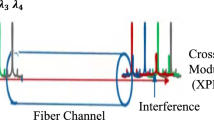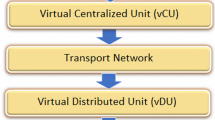Abstract
In this work, a 16 × 100 Gbps optical single sideband (OSSB) modulation based dual polarized (DP) Mach–Zehndar Modulators and polarizer in DP-Quadrature phase shift keying (DP-QPSK) with coherent optical Orthogonal frequency division multiplexing (CO-OFDM) is proposed over inter-satellite optical wireless link (IsOWC). Carrier phase estimation, frequency offset estimation and nonlinear compensation are performed by incorporating digital signal processing (DSP) in the system. Proposed OSSB generation has ability to provide tunable optical carrier to sideband ration by adjusting polarization controller and mathematical principle is also discussed. Security of the system is improved by employing matched filter prior to DSP which has property of noise rejection i.e. waveforms can be detected in presence of jammer. Further, a comparison of proposed system is performed with QPSK-IsOWC, DP-QPSK-IsOWC, and DP-QPSK-CO-OFDM-IsOWC systems in terms of log BER, error vector magnitude, received power, and optical signal to noise ratio. It is observed that proposed system can cover 15,900 km at 100 Gbps at targeted log BER of − 2.42 and provides enhanced performance. As per author’s best of knowledge, IsOWC system with such bandwidth efficient spectrum, high performance and security has not been reported in the past.











Similar content being viewed by others
Data availability
All the relevant data is included in this article.
References
Grover, A., Sheetal, A., & Dhasarathan, V. (2020). 20Gbit/s-40 GHz OFDM based LEO-GEO Radio over Inter-satellite optical wireless communication (Ro-IsOWC) system using 4-QAM modulation. Optik, 206(164295), 1–13.
Grover, A., & Sheetal, A. (2020). A 2 × 40 Gbps mode division multiplexing based inter-satellite optical wireless communication (IsOWC) system. Wireless Personal Communications, 114, 2449–2460.
Chaudhary, S., Sharma, A., & Chaudhary, N. (2016). 6 × 20 Gbps hybrid WDM–PI inter-satellite system under the influence of transmitting pointing errors. Journal of Optical Communications, 37(4), 375–379.
Singh, M., & Malhotra, J. (2019). A high-speed long-haul wavelength division multiplexing-based inter-satellite optical wireless communication link using spectral-efficient 2-D orthogonal modulation scheme. International Journal of Communication Systems, 33(6), e4293 (1-13).
Kaur, R., & Kaur, H. (2018). Comparative analysis of chirped, AMI and DPSK modulation techniques in IS-OWC system. Optik-International Journal of Light Electron Opttics, 128, 755–762.
Kaur, S., Kaur, G., Singh, G., Verma, A., & Julka, N. (2017). Polarization crosstalk suppression in wavelength division multiplexed free space optical system incorporating polarization diversity. IJCRT, 5(3), 384–390.
Kaur, S., Kumar, M., & Verma, A. (2019). An integrated high-speed full duplex coherent OFDM-PON and visible-light communication system. Journal of Optical Communication. https://doi.org/10.1515/joc-2018-0236
Majeed, M. H., Ahmed, R. K., & Alhumaima, R. S. (2021). Performance analysis of inter-satellite optical wireless communication (IsOWC) system with multiple transmitters/receivers. IOP Conference Series Materials Science and Engineering, 1076, 012052.
Kaur, R., & Kaler, R. S. (2020). Performance of zero cross correlation resultant weight spectral amplitude codes in lower Earth orbit-based optical wireless channel system. International Journal of Communication Systems, 33(19), 1–10.
Zhu, Z., Zhao, S., Li, Y., & Li, X. (2014). Performance comparison of analogue inter-satellite microwave photonics link using intensity modulation with direct detection and phase modulation with interferometric detection. IET Optoelectronics, 9(2), 88–95.
Garg, D., & Nain, A. (2021). Next generation optical wireless communication: A comprehensive review. Journal of Optical Communication. https://doi.org/10.1515/joc-2020-0254
Viswanath, A., Jain, V. K., & Kaur, S. (2017). Reduction in transmitter power requirement for earth-to-satellite and satellite-to-earth free space optical links with spatial diversity. Optical Quantum Electronics, 49(12), 418.
Khalighi, M., & Uysal, M. (2014). Survey on free space optical communication: A communication theory perspective. IEEE Communications Surveys and Tutorials., 16(4), 2231–2258.
Sodnik, Z., Furch, B., & Lutz, H. (2010). Optical intersatellite communication. IEEE Journal of Selected Topics in Quantum Electronics, 16(5), 1051–1057.
Gill, H. K., Singh, N., & Walia, G. K. (2019). Comparative investigation of CSRZ-DQPSK, DRZ-DQPSK, and MDRZ-DQPSK modulation techniques in MDM IS-OWC system. MOTL, 61(7), 1802–1809.
Pelton, J. N. (2013). Satellite Orbits for Communications Satellites, Handbook of Satellite Applications (pp. 93–114). Springer. https://doi.org/10.1007/978-1-4419-7671-0_5
Sun, Z. (2005). Networking, Satellite, Principles and protocols. Wiley.
Polishuk, A., & Arnon, S. (2004). Optimization of a laser satellite communication system with an optical preamplifer. Journal of the Optical Society of America A, 21(7), 1307–1315.
Sharma, V., & Chaudhary, S. (2014). High speed CO-OFDM-FSO transmission system. Optik, 125(6), 1761–1763.
Elsayed, E. E., Yousif, B. B., & Alzalabani, M. M. (2018). Performance enhancement of the power penalty in DWDM FSO communication using DPPM and OOK modulation. Optical Quantum Electronics, 50(7), 282.
Alatwi, A. M., Rashed, A. N. Z., & El-Gammal, E. M. (2020). Wavelength division multiplexing techniques based on multi transceiver in low earth orbit intersatellite systems. Journal of Optical Communications. https://doi.org/10.1515/joc-2019-0171
Garg, N., & Tripathi, A. (2019). Comparison of different modulations with proposed hybrid WDM-TDM inter-satellite. Optical Wireless System, 2(10), 118–126.
Gill, H. K., Walia, G. K., & Grewal, N. S. (2018). A review on FSO and IS-OWC system along with mode division multiplexing. Advanced Research in Electrical and Electronic Engineering, 5(2), 105–109.
Patnaik, B., & Sahu, P. K. (2012). Inter-satellite optical wireless communication system design and simulation. IET Communications, 6(16), 2561–2567.
Chaudhary, S., Sharma, A., & Singh, V. (2019). Optimization of high speed and long haul inter-satellite communication link by incorporating diferential phase shift key and orthogonal frequency division multiplexing scheme. Optik, 176, 185–190.
SarathGanga, S., Asha, R. S., & Shaija, P. J. (2016). Design of a standardized inter satellite optical wireless communication (IsOWC) system with minimum input power. Procedia Technology, 25, 567–573.
Kaur, N., & Soni, G. (2015). Performance analysis of inter-satellite optical wireless communication (IsOWC) system by using NRZ and RZ modulation. International Journal of Scientific and Research Publications, 5(1), 1–5.
Kaur, M. (2017). Design and analysis of ultra high capacity dwdm system with and without square root module for different modulation formats. IJARCS, 8(5), 1714–1719.
Sharma, V., Singh, G., & Kaur, B. (2016). Comparison analysis of ultra, visible and infra high capacity intersatellite optical wireless communication system using distinct modulation formats. International Journal of Engineering Applied Science and Technology, 2(1), 62–66.
Gupta, A., Singh, A., & Bakshi, S. (2017). Digital signal processing of 400 Gbps CO-QPSK-WDM system over optical wireless channel for carrier phase estimation. Wireless Personal Communication, 99(1), 111–120.
Singh, M., & Malhotra, J. (2020). Modeling and performance analysis of 400 Gbps CO-OFDM based inter-satellite optical wireless communication (IsOWC) system incorporating polarization division multiplexing with enhanced detection. Wireless Personal Communications, 111(4), 1–17.
Chaudhary, S., Tang, X., Sharma, A., Lin, B., Wei, X., & Parmar, A. (2019). A cost-efective 100 Gbps SAC-OCDMA–PDM based inter-satellite communication link. Optical and Quantum Electronics, 51, 1–10.
Shivakumar, P., Malhotra, J., & Dhasarathan, V. (2020). Performance analysis of 160 Gbit/s single-channel PDM-QPSK based inter-satellite optical wireless communication (IsOWC) system. Wireless Networks, 26, 3579–3590.
Padhy, J. B., & Patnaik, B. (2019). 100 Gbps multiplexed inter-satellite optical wireless communication system. Optical and Quantum Electronics, 51(213), 2–16.
Sharma, V., & Kumar, S. (2013). Empirical evaluation of wired-and wireless-hybrid OFDM–OSSB–RoF transmission system. Optik-International Journal for Light and Electron Optics, 124(20), 4529–4532.
Sharma, V., & Kaur, A. (2014). Modeling and simulation of long reach high speed inter-satellite link (ISL). Optik, 125(2), 883–886.
Blais, S. R., & Yao, J. (2006). Optical single sideband modulation using an ultranarrow dual-transmission-band fiber bragg grating. IEEE Photonics Technology Letters, 18(21), 2230–2232.
Shen, Y., Zhang, X., & Chen, K. (2005). Optical single sideband Modulation of 11-GHz RoF system using stimulated Brillouin scattering. IEEE Photonics Technology Letters, 17(6), 1277–1279.
Smith, G. H., Novak, D., & Ahmed, Z. (1997). Technique for optical SSB generation to overcome dispersion penalties in fibre-radio systems. Electronics Letters, 33(1), 74–75.
Xue, M., Pan, S. L., & Zhao, Y. J. (2014). Optical single-sideband modulation based on a dual-drive MZM and a 120° hybrid coupler. Journal of Lightwave Technology, 32(9), 3317–3323.
Safavi, N., Hosseini, S. E., Jamshidi, K., & Plettemeier, D. (2019). Optical single sideband polarization modulator with tunable optical carrier-to-sideband ratio and its applications in microwave photonic phase shifter and optical frequency shifter. Applied Optics, 58(30), 8213–8220.
Wang, W. T., Liu, J. G., Mei, H. K., & Zhu, N. H. (2016). hase-coherent orthogonally polarized optical single sideband modulation with arbitrarily tunable optical carrier-to-sideband ratio. Optics Express, 24(1), 388–399.
Li, S., Cai, L., Gao, X., & Lu, L. (2020). Optical single-sideband modulation with tunable optical carrier-to-sideband ratio based on a dual-polarization Mach-Zehnder modulator and a polarizer. Journal of Russian Laser Research, 41, 285–290.
Zong, K., & Jiang, Z. (2018). Multiband DSB-SC modulated radio over IsOWC link with coherent homodyne detection. Proceedings of the SPIE, 10697, 106975H. https://doi.org/10.1117/12.2309301
Zong, K. (2018). “Transparent intersatellite optical wireless communication link with double sideband-suppressed carrier modulation and coherent homodyne detection. Applied Optics, 57(32), 9464–9470.
Tickoo, S., & Gupta, A. (2016). A novel approach to design a bi-directional radio over fiber SCM/ASK system for future generation networks. Indian Journal of Science and Technology, 9(36), 1–6.
Yousif, B., Metwally, I. E., & Samra, A. S. (2019). A modified topology achieved in OFDM/SAC-OCDMA-based multi-diagonal code for enhancing spectral efficiency. Photonic network communications, 37(1), 90–99.
Okoshi, T., & Kikuchi, K. (1988). Coherent optical communication systems. KTK Scientific Publisher.
Kikuchi, K. (2011). Digital coherent optical communication systems: Fundamentals and future prospects. IEICE Electronics Express, 8(20), 1642–1662.
Jaradat, A., Hamamreh, J., & Arslan, H. (2019). Modulation options for OFDM-based waveforms: Classification, comparison, and future directions. IEEE Access, 7, 17263–17278.
Ali, N., Almahainy, R., Al-Shabili, A., Almoosa, N., & Abd-Alhameed, R. (2017). Analysis of improved µ-law companding technique for OFDM systems. IEEE Transactions on Consumer Electronics, 63(2), 126–134.
Shieh, W., & Djordjevic, I. (2009). OFDM for optical communications (pp. 31–52). Academic Press.
Li, L., Xiao-bo, G., & Jing, L. (2016). Analysis of performance for 100 Gbit/s dual-polarization QPSK modulation format system. Journal of Optical Communication, 37(1), 93–101.
Singh, H., Singh, H., & Arora, D. (2019). Hybrid technique to reduce PAPR in OFDM. In P. Singh, M. Paprzycki, B. Bhargava, J. Chhabra, N. Kaushal, & Y. Kumar (Eds.), Futuristic Trends in Network and Communication Technologies. FTNCT 2018. Communications in Computer and Information Science. (Vol. 958). Springer. https://doi.org/10.1007/978-981-13-3804-5_6
Author information
Authors and Affiliations
Corresponding author
Additional information
Publisher's Note
Springer Nature remains neutral with regard to jurisdictional claims in published maps and institutional affiliations.




